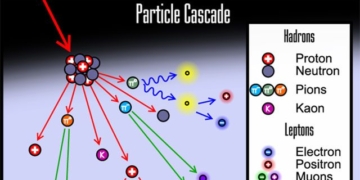A Scientific Study Offers Advice on Nuclear Disaster, Including the Worst Places to Seek Shelter.
The study published in the journal Fluid Physics, authored by scientists Ioannis W. Kokkinakis and Dimitris Drikakis, specifically examined the damage caused by shock waves generated by a nuclear explosion. These shock waves are often strong and fast enough to lift a person off the ground.

While it may be an unlikely scenario, what would you do if a nuclear bomb were detonated? (Illustrative image).
However, the study did not address the effects of radiation, which is a lingering and widespread factor following an explosion. The report states: “While shielding from a nuclear bomb would be unavoidable if you are in the affected area, there are still important considerations to keep in mind.”
Based on simulations using supercomputers, the research team found significantly more dangerous locations compared to others (in terms of shock waves). “The most dangerous places in a home include: windows, hallways, and doorways,” said author Ioannis Kokkinakis. “People should avoid these areas and seek immediate shelter.”
Next, find a windowless room or a closet. This may be the best option in an emergency, the report notes.

The atomic bomb dropped on Hiroshima, Japan. (Photo: History).
Notably, there was previously a belief that people taking shelter inside buildings made of reinforced concrete could withstand shock waves from a nuclear explosion. However, this new study contradicts that notion.
In fact, the confined spaces inside rooms and buildings can contribute to the speed of shock waves, creating “winds” that can tear at corners with a force 18 times the weight of a human body.
Author Dimitris Drikakis emphasized: “Our new research shows that high-speed waves remain a significant danger, potentially leading to serious injuries or even death. However, standing in a confined room is still better than being in a room with many windows or doors.”
In addition to the impact of shock waves, one cannot overlook the destructive power of the nuclear reactions within atomic bombs. In the case of early atomic bombs, such as the two dropped on Hiroshima and Nagasaki, it involves a series of fission reactions.
Fission occurs when a neutron interacts with the nucleus of an isotope, such as uranium-235 or plutonium-239. This process splits the nucleus and releases energy along with additional neutrons, creating a chain reaction.

An atomic bomb creates a massive destructive force over a wide area. (Illustrative image: Getty).
Terrifyingly, all of these processes almost instantly release an enormous amount of energy, more than any conventional explosive.
If a nuclear bomb detonates, people in surrounding areas will only have a few seconds to move to a safe location before a shock wave strikes.
The researchers hope that by enhancing our understanding of safe shelter locations, victims in affected areas may be able to save their lives in the event of a disaster.





















































